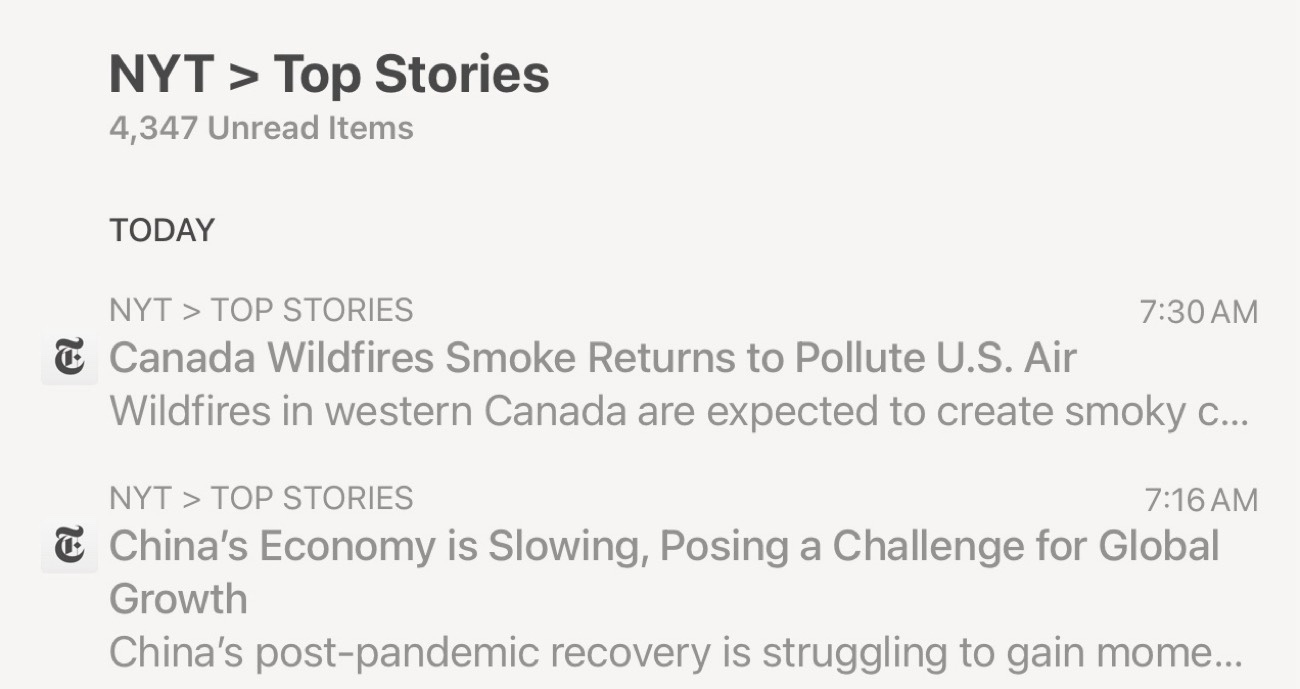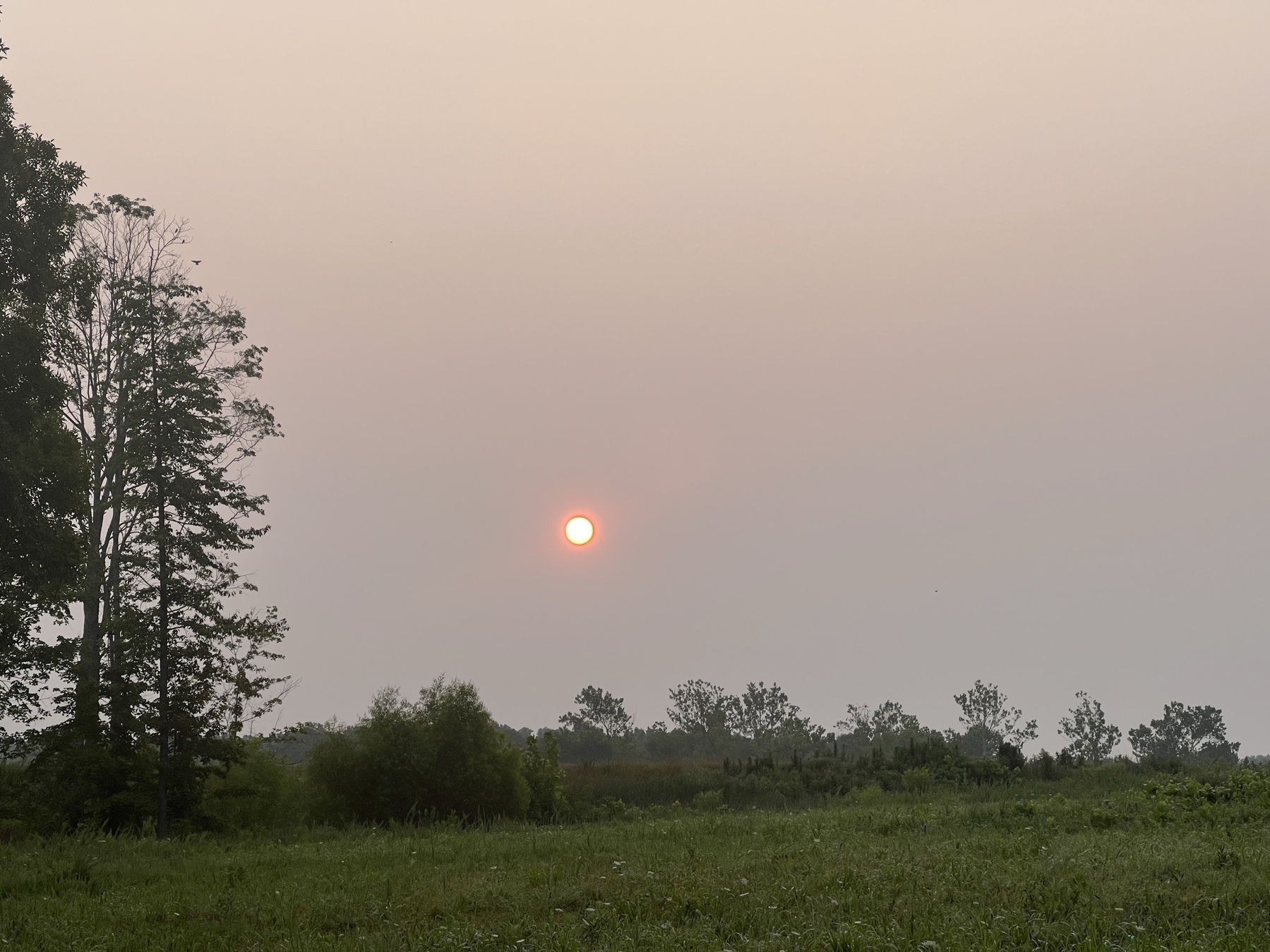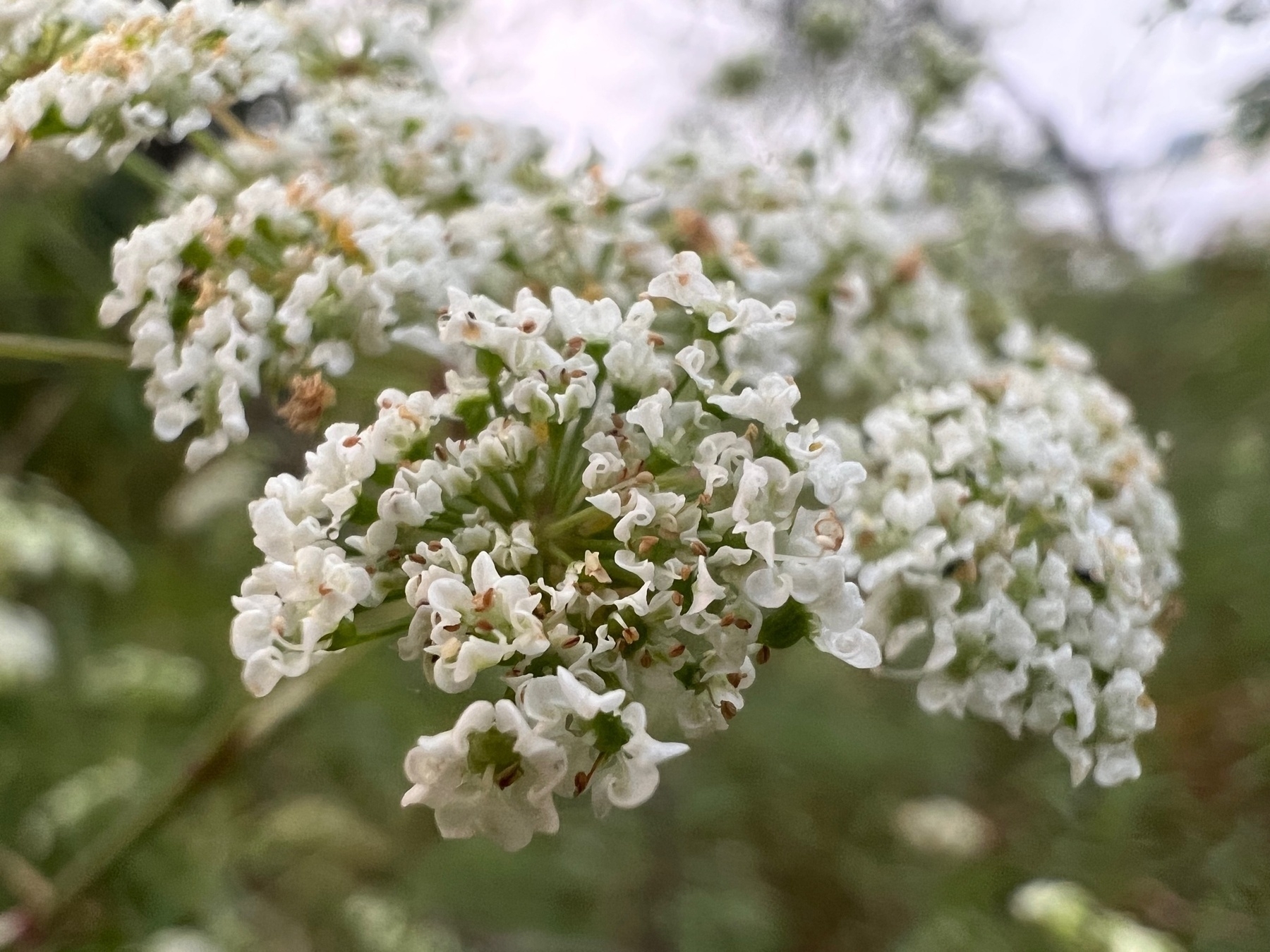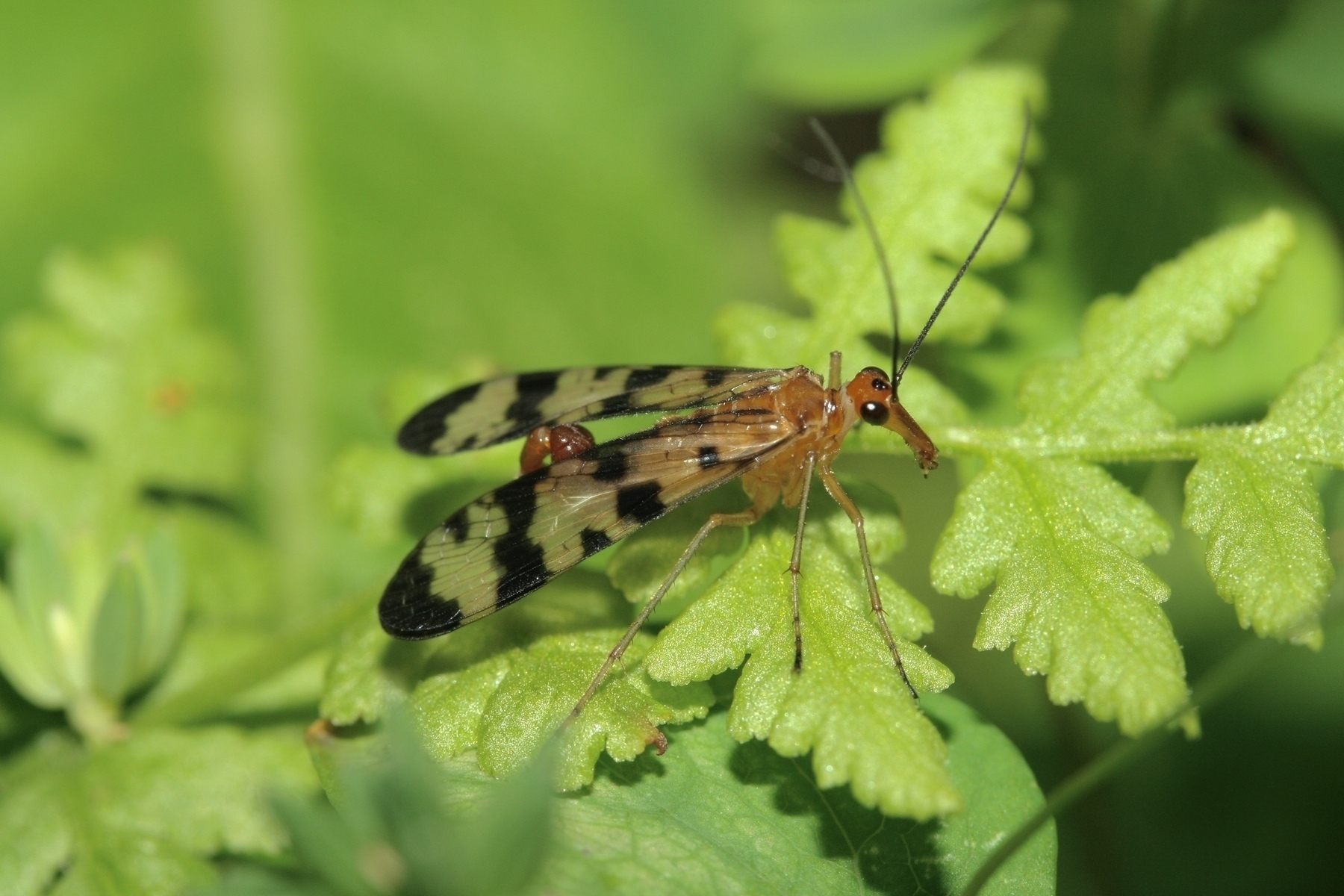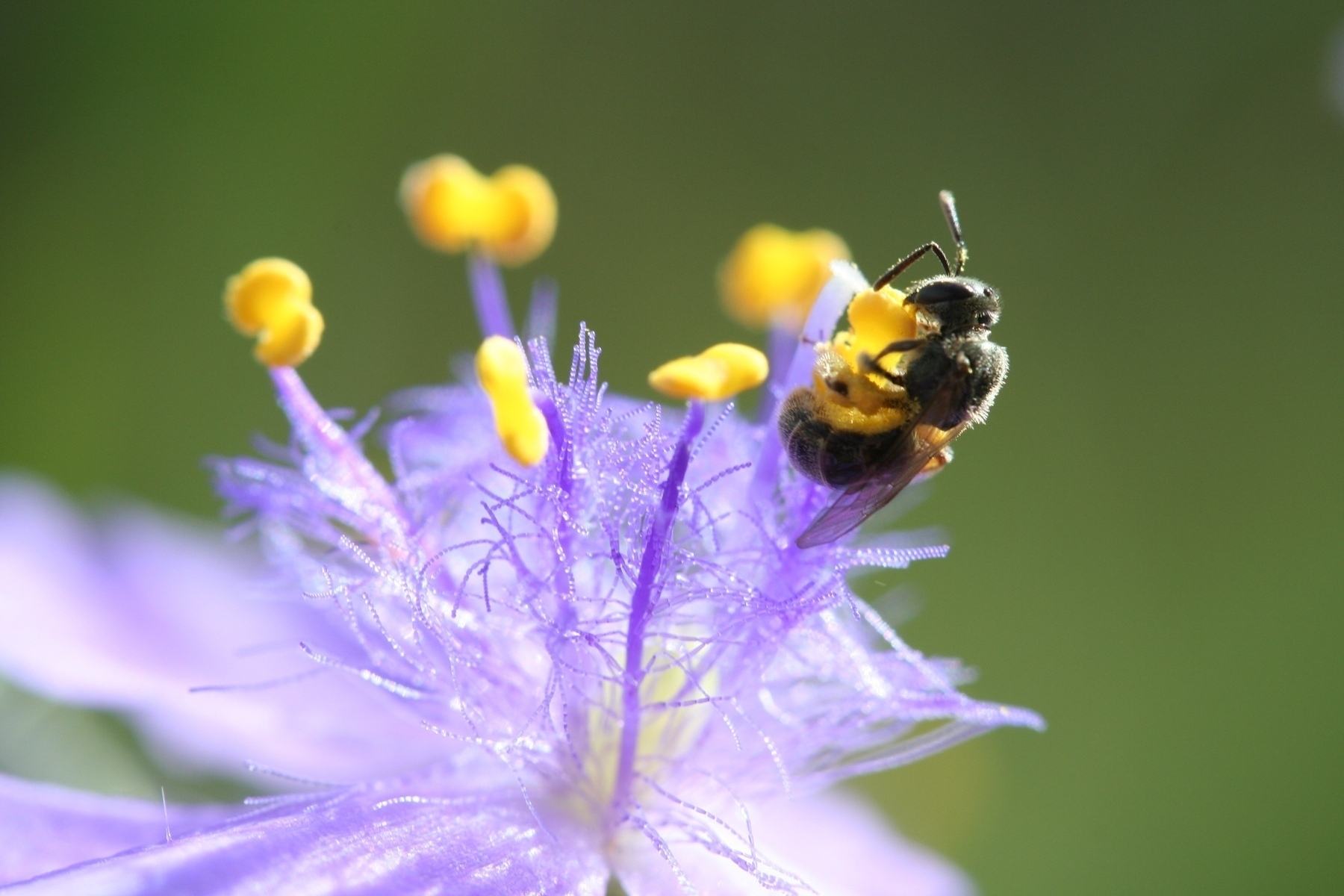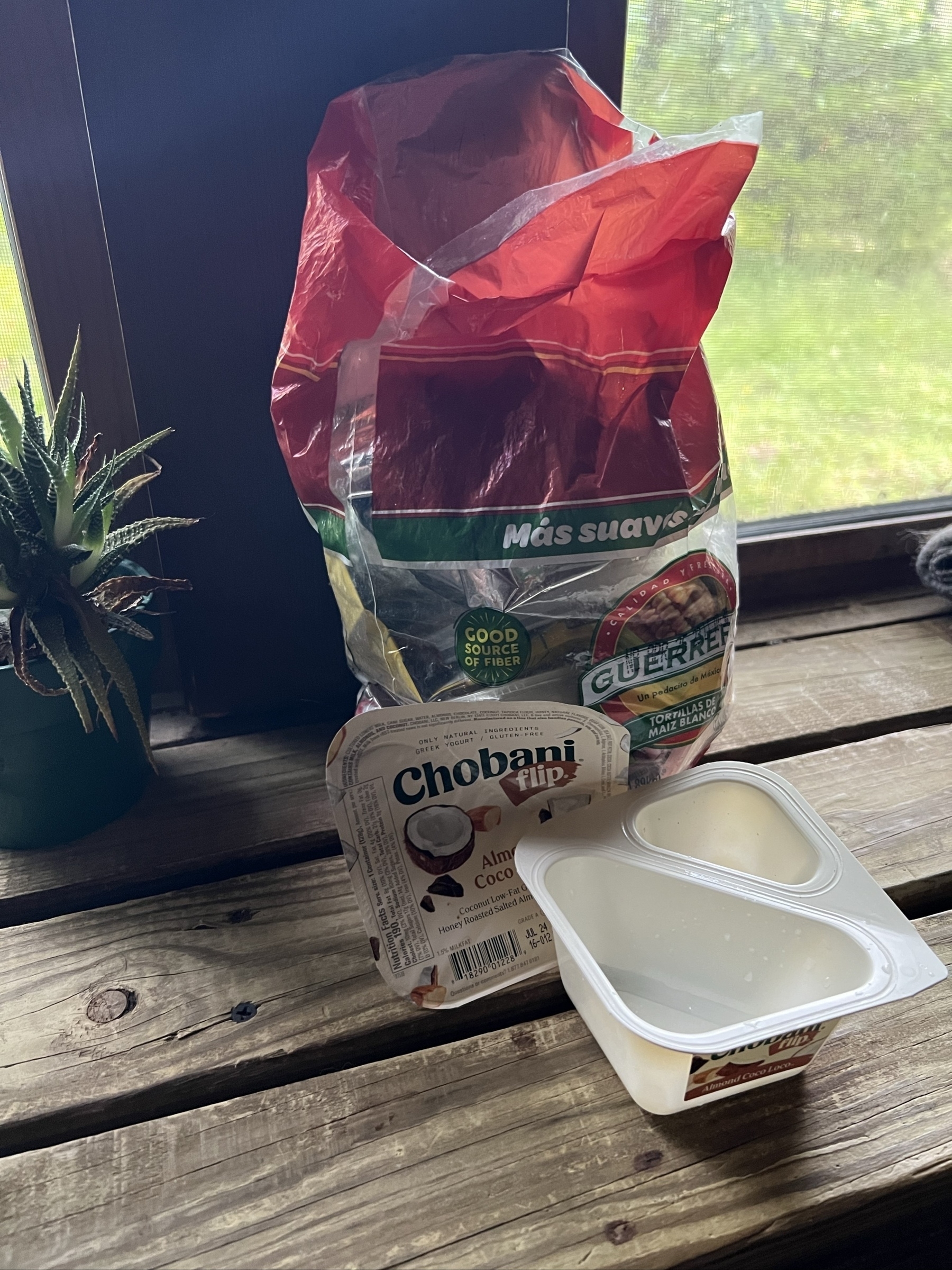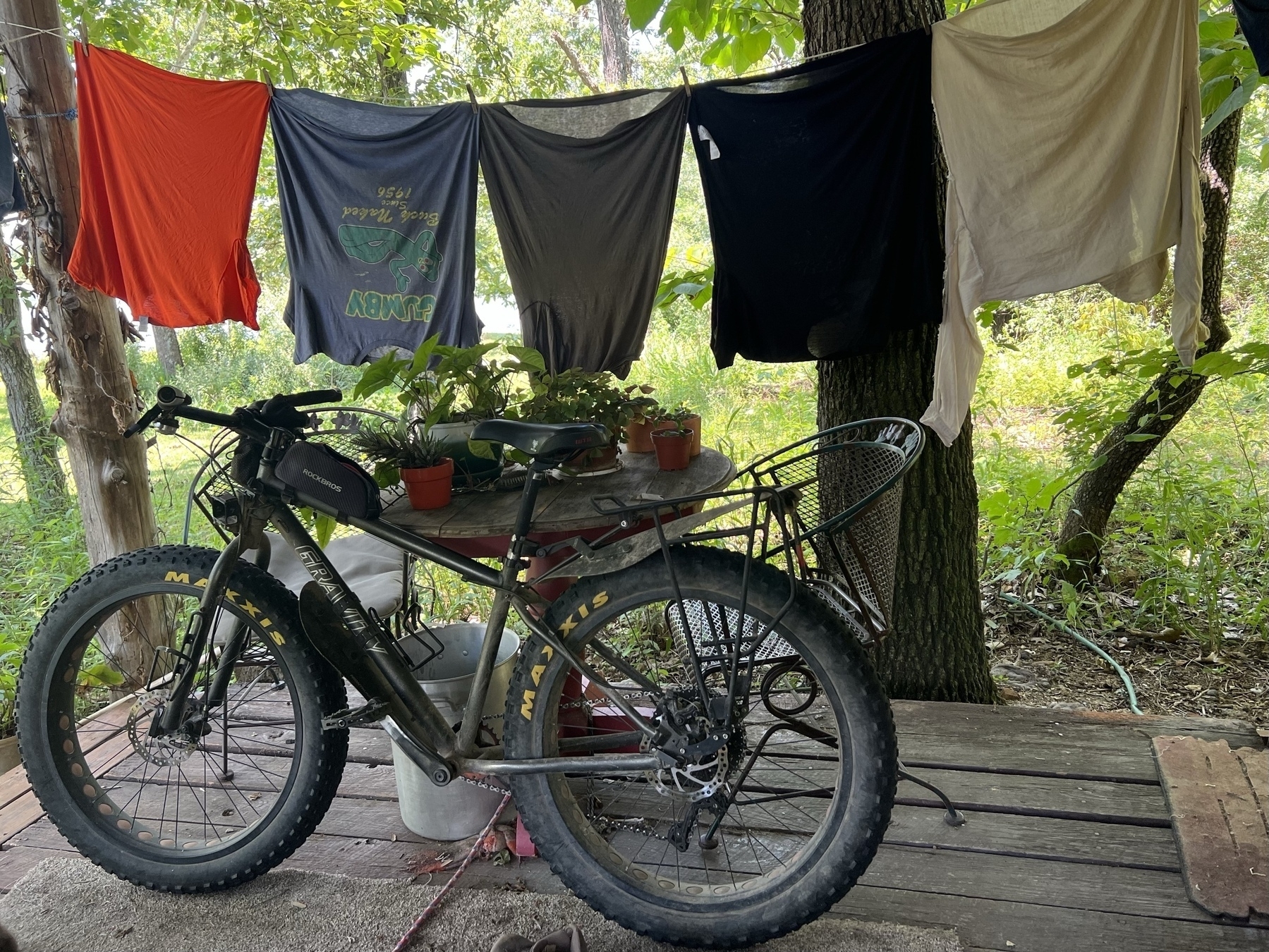See the problem here?
Capitalism and its insistence on perpetual growth is not, and will never be, compatible with solving the climate crisis. Nor is it concerned with human or ecological health in general.
From the morning walk. The smoke from the Canadian wildfires has made its way down to mid Missouri, a bit hazy this morning, but a pretty sunrise.
Spotted water hemlock, Cicuta maculata, highly poisonous.
Nate Hagens, the director of the Institute for the Study of Energy & Our Future, ran the numbers: “One barrel of oil has the same amount of energy of up to 25,000 hours of hard human labor, which is 12.5 years of work. At $20 per hour, this is $500,000 of labor per barrel.” A barrel of oil costs about seventy dollars at this week’s market price.
What do our lives and our world look like without fossil fuels? For example, imagine the full process and energy that goes into the flour used in a simple loaf of bread.
To Save the Planet, Should We Really Be Moving Slower? | The New Yorker
The easy way to move Safari tabs on iPad into tab groups. Rather than individually long pressing tabs to move just drag and drop directly from the tab bar or use the tab overview. Multitouch tap and hold to select multiple tabs then drag into group in sidebar. Why haven’t I tried this before?
Futzing around in my photos, these were taken a few years back.
Panorpa helena, scorpion fly.
Unknown bee on Spiderwort
A neighbor is driving to Florida for a vacation and offered me a couple of things she would otherwise throw away, the yogurt in the image. Contrast that waste with the bag behind it which contains the totality of my waste for 3 weeks.
Waste reduction is not an option for future life on our planet.
Early days of the climate emergency:
Northern India has been experiencing severe rains which have caused deadly flash floods and landslides, killing at least 22 people. On Sunday, Delhi had its wettest day in more than four decades…
In the US, intense rain and flash flooding left at least one person dead in southeastern New York.
While heavy rainfall events will always happen, scientists say that climate change means they are becoming more severe.
Japan: Floods and mudslides kill six as scientists warn extreme rainfall events will get worse | CNN
iPadOS 17: Improved file content indexing
For iPad users, it appears that with iPadOS 17 beta file contents are more thouroughly indexed and revealed in Files app search results than previously. Some of these were indexed before but some are new. I’m seeing results from text/html/markdown files in app folders for Notebooks, iA Writer and Textastic. Also content search results for pdfs, Numbers and Pages documents.
Climate disasters, fueled by large-scale, human-driven changes in the global climate, are becoming more frequent. In the past few weeks in Vermont, we’ve had wildfire smoke from Canada forcing people to stay inside, a heat wave, and now this flooding. And Vermont is a place that is supposedly safer for climate refugees to go. But that’s the thing about a global climate crisis: it’s going to affect absolutely everyone absolutely everywhere.
This is just the very beginning, the first days of the long climate emergency that won’t have an end in our lifetimes.
…when I look at Threads what I see is an influencer-infested, brand-driven, algorithmically-jammed-up crapfest. A lot like, well, modern Instagram…
My point is that Threads and Mastodon are already really different culturally. … At the end of the day, I’m a Mastodon partisan. But I don’t love its collective tendency toward self-important dogmatism.
I think this is the most thoughtful take on Mastodon and Threads I’ve read yet. So much better than the reactive hot takes flying around.
Coyote Cartography - You’re So Vain, You Probably Think This App Is About You: On Meta and Mastodon
Low-tech, low cost climate solutions that are easy to implement. Admittedly, a bike has some cost and upkeep. Still though, fairly inexpensive. Side benefit: exercise.
The laundry line and clothespins are about $5 and easy to do outside or even inside. No cost to operate or maintain.
This week unprecedented temperatures driven by climate change shattered heat records around the world. “We can’t stop global warming at this point. All we can do is try to stop it short of the place where it cuts civilizations off at the knees.”
“This is the last of these moments we’re going to have when the world is summoned to action by events and when there’s still time to make at least some difference in the question of how hot it ultimately gets.”
Bill McKibben: Climate Crisis Needs Urgent Action as Earth Records Hottest Temps Ever - YouTube
Sunday morning reflection on our moment in the cosmos
On a clear night, we are blessed with a wonderful view of a star filled sky. Tonight, just before turning in, I stopped to stair up at the glittering patterns above me, and the vastness of heavens that our tiny planet sits in. I find something quite calming and humbling viewing that site.
It really is calming and humbling. We’re so, so tiny in the vastness of it all. With just our eyes we can only see perhaps 6,000 stars in our night sky. But our galaxy contains billions! And then to consider the vast space between each star, that the photons from those distant stars have traveled for thousands of years only to end their journey when they strike the eye of a tiny little mammal on a tiny little planet.
The more I’ve learned of the cosmos the more insignificant I’ve felt within it. But in a good way. To feel in size and temporality like a rain drop in a brief moment falling to the Earth. And the Earth, in the cosmos, just one planet around one star amonst 200 billion other stars in our galaxy alone. And to think there are 200 billion other galaxies? We are infinitesimal. Insignificant and yet significant.
Several years ago I was in the habit a spending lot of time with a telescope looking at stars, nebulae, galaxies and our nearby planetary neighbors. It was a kind of meditation on the above, trying to understand, or, to just begin to grasp, the reality of our existence in the vastness of time and space. Those long nights in the dark, looking up at stars thousands of light years away and the faint galaxies that were millions of light years away, letting my mind imagine the many possible worlds that might exist. To consider the possibility of other life forms, some possibly intelligent also looking up into the vastness of space just as I was, brought a strange mix of emotions. My mind would slowly vacillate from a kind of deep peace and sense of belonging even as I felt and acknowledged the indifference of the cosmos. That my life was the single momentary flicker of a summertime firefly and so too is that of humanity, just a moment. Night after night I both rested and grappled with these thoughts and the realizations that drifted from them.
We humans have only existed on this planet for 300,000 years (in our “modern form”). Just a blink of an eye in Earth history and even less in the history of the cosmos. For most of our existence it might have been difficult for a off-world visitor to even know humans were here. We fit into our landscape quietly. Just thousands slowly growing into millions. And then of course things changed. Our industrial civilization with its various conflicts and social forms has only a few hundred years. For all of our intelligence, we’re not very good at living our lives in the larger context. For the most part we’re not able to hold in our minds and daily lives a reverence for our moment in this larger continuum. As animals we react to what’s in front of us right now. It would seem our brains, in terms of evolutionary biology, are tuned to exist only in the moment as it exists in the much smaller context of our lived time and space. It makes sense for short term survival.
And yet, that moment-to-moment instinct to survive works against us. In some ways, not all that different from a bird or a squirrel, we focus on the immediacy of our days. The human dramas that play out in front of us in our homes, schools, and neighborhoods. And not content with those physical, “in real life” connections, we’ve created ways to interact via small glass screens with people all around our planet. Connecting but not connecting. War and conflict continue despite our increased ability to communicate. Planetary-scale problems, most notably climate change, deepen into crisis as we fail to grasp the imbalance we’ve imposed upon the delicate and fragile biosphere.
And so here we are. Tiny and alone on a planet that has, over 4.5 billion years evolved an incredibly diverse life support system. As a species we have simultaneously come to understand the complexity of our biosphere even as we’ve increased our exploitation of it. And so it is that with more than 8 billion of us, we are slowly coming to grasp the full scope of our crises. We have pushed our life support system to the edge. And yet, as I type these words, just outside my window everything seems normal. I hear a variety of birds going abut their lives, singing to one another in the forest. My impression at this moment is that everything is okay. There is no obvious crisis to be seen in my world in this moment. It would be easy to say that this planet is resilient, that it has been here for a long time and will go on.
And you know what? It will. It will. But we have changed it. Our planet is now caught up in a process from which there is no turning back. We are in it. My morning thoughts are of both the special significance of life on our planet, of the long evolution our complex biosphere but also of our place in the universe. Whatever happens on our planet in the next few months and years, whether we rise to the challenge of changing course, the planet will be here in a hundred years. A thousand years. Despite the havoc we have unleashed, life here will evolve to adapt. Much will be lost. In this tiny, tiny corner of the galaxy a species of animal that called itself Homo sapiens lived for a short time. To some degree came to know itself and its place in the larger cosmos. And then it flickered out. By its own hand or some other larger, cosmic event.
I struggle daily trying to come to terms with what we’ve done. But when I look up into the vastness of the night sky, at the thousands of nearby stars or the distant galaxies millions of light years away, I settle into a kind of understanding, an acknowledgment of the moment. As many others have said, we are made of star stuff and we’ll return to that one way or another. The universe doesn’t care. Whatever happens here, today, our planet will continue to spin on its axis as it revolves around the sun which will continue its journey around the galaxy. Our sun and solar system take 200+ million years to make one full orbit around the galactic center. For perspective, the last time our sun was in this place in its orbit the dinosaurs roamed the planet. They lasted millions of years.
I’m not sure how long humans last but this is our moment.
June 2023 may be remembered as the start of a big change in the climate system, with many key global indicators flashing red warning lights amid signs that some systems are tipping toward a new state from which they may not recover.
“These extraordinary extremes could be an early warning of tipping points towards different weather or sea ice or fire regimes… We call it ‘flickering’ when a complex system starts to briefly sample a new regime before tipping into it. Let’s hope I’m wrong on that.”
June extremes suggest parts of climate system are reaching tipping points | Ars Technica
I love the visual design of Apple’s Weather app on iPhone and iPad. Love it. But it’s always wrong. The only time it’s not wrong is current conditions which is only sometimes wrong.
I’m using Foreca instead. Has excellent widgets including live radar and a one time purchase option. You?
Lol, I’m not sure why I do this but yet again I’ve started a comment to an article that has turned into a full-on post. Entertainment? I suppose I might as well share it. This one was a post by Michael Tsai in which he references a generally positive post by Jesse Peterman who recently wrote about trying an iPad Pro for Coding. I suppose that this is really a reply to both Michael and Jesse. In summary, I think Jesse’s post was fair and accurate though several of the comments on his blog do mention solutions that he was unaware of so it may be that at least some of his critiques were actually met by those apps.
Often times such pieces are written from the perspective of users who have been using Macs or Windows for a long time. I’ve lost track of the times I’ve come across posts by people that wanted to “try an iPad as my main computer” and then a week or month later they conclude it’s not possible because it was a different experience from what they were used to. In a short time frame there’s a lot more friction as a new-to-iPad user settles in. Windowing and multitasking seem to be be the initial primary obstacles but then also, sometimes, needed apps that are not available or if an app is available it’s not an exactly match to the version they’re used to.
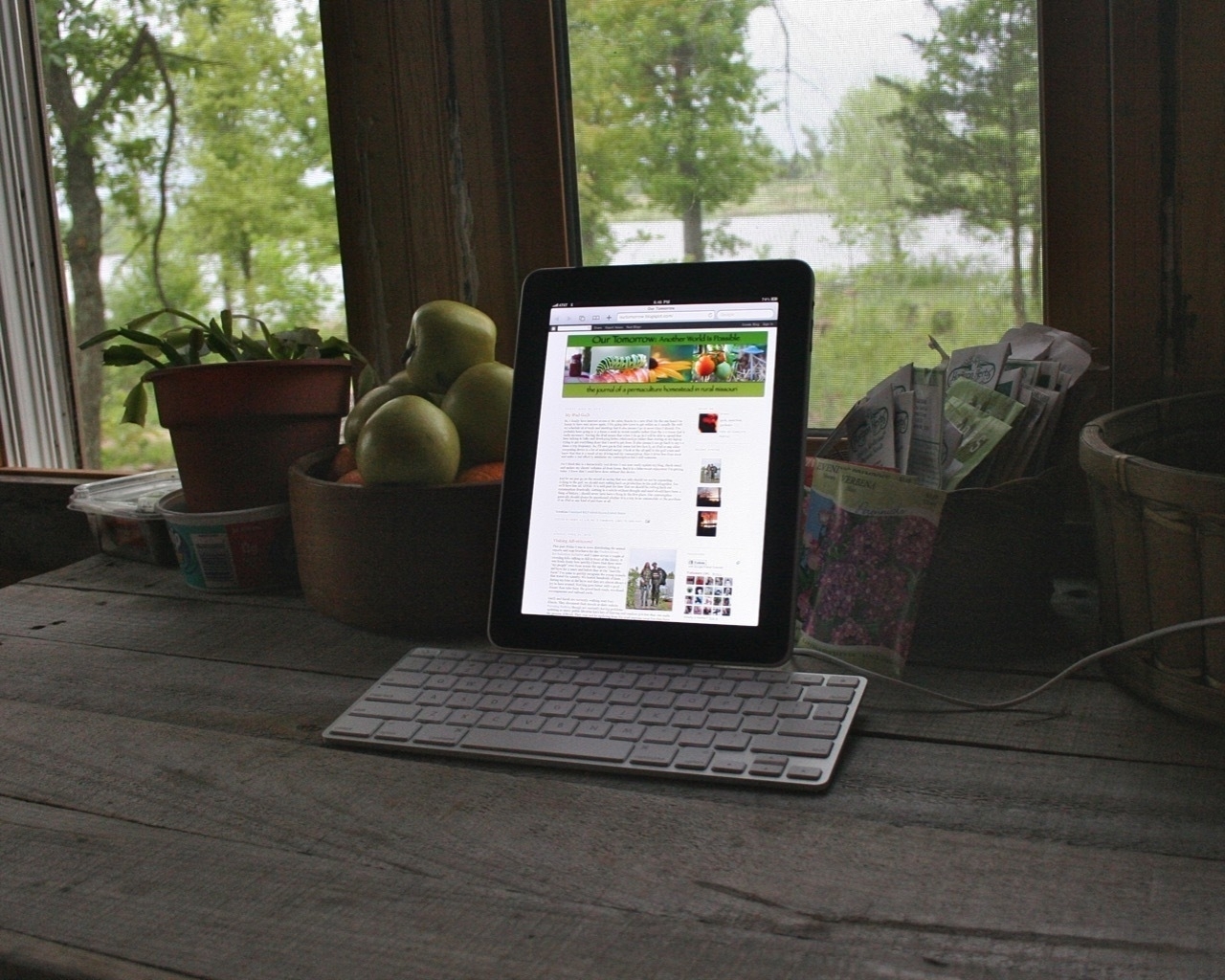 My original iPad docked in Apple’s Keyboard Stand
My original iPad docked in Apple’s Keyboard Stand
I came to the iPad as a long time Mac user (A Color Classic and System 7.6). Like many I bought the first iPad and in those days was happy to use it as a tablet along side of my Mac. But I also bought it with the the Keyboard Stand accessory that Apple sold and within the first few months had found an app, Gusto, that was built for managing/coding websites. It had a very similar feel to Panic’s Coda with a sites window with thumbnails, an excellent text/html editor and a built in ftp client. Well, that gave me my first taste of “using the iPad for real work”. Given that much of my work then (and now) involved setting up and maintaining small, static websites in the old school html/css/ftp way, well, I was actually quite happy with that set-up.
Over the next few years I happily bounced back and forth between the Mac and iPad. In those early days I relied on the Mac for graphics focused work and the iPad for reading, writing, blogging and code. Around 2016 Serif started releasing iPad versions of their apps and that allowed me to switch over another chunk of my work. None of this was planned, I enjoyed using my Mac and iPad together. But when given the opportunity I usually chose the iPad if it was the right tool for the job. By that time I’d learned all of the gestures and with each new year I learned any new gestures, new features, etc.
Using the iPad beyond casual consumption requires mastery of its interface and an interest in taking advantage of what makes it different: the touch screen. This is really key and seems obvious but many seem to overlook it when discussing features, price and limitations. Of course a 13" iPad Pro is going to be quite expensive, its got a large glass touch screen. In some ways it is more limited and these days its battery life is less than the M-based Macs. And yes, it’s heavier than some when you add in the keyboard.
I still keep a Mac Mini around as a file server and as a back-up but sold my MBP back in 2017. I feel a bit like a ninja or a wizard with the iPad. Being able to use it without a keyboard is something I really value. I long ago mastered the many multi-touch gestures that are available and my fingers are always dancing across the glass. I enjoy that experience. But the keyboard is always nearby and about 50% of the time is attached and I’m happily using the keyboard, trackpad and touchscreen together. And still other times I’ve also got an external monitor attached.

We’re 8 years in since the release of the 1st iPad Pro and though the evolution of iPadOS has been too slow for some I’ve found the last three years of features have added up to a refined user experience that brings a more flexible, powerful range of possibilities for anyone that wants to take advantage of a touch screen, modular form factor. Really, at the end of the day, I like to celebrate the fact that we have so many Apple computers to choose from because it also means so many more people get to have the comfortable computing experience that lets them do more. It’s a win for everyone.
If using the iPad is something you’re interested in I’ve written 100+ iPad focused posts.
What’s difficult about living through history is you often don’t know the magnitude of it all until it’s over. But at this rate, things being “over” might mean us not being around to look back at it at all.
In this particular case of living through history, Earth just logged the hottest global temperature ever recorded three days in a row—and perhaps the hottest it’s been in some 125,000 years. The earliest known human use of symbols dates to around the same time.
You Just Lived Through the Three Hottest Days on Earth—And More Is Coming | The New Republic
I’ve been a very satisfied subscriber of the hosted micro.blog service for around eight months. It’s excellent and I’ve recommended it in many places to anyone interested in a blog. I’ve moved both of my WordPress blogs to Micro.blog. The quality of the hosted service is why I’m here.
The timeline feature is a bit of a mixed bag. The main timeline of posts of those I follow is excellent. But the Discover timeline, has, over time, proven to be a bit disappointing and sadly, this is due to intentional design choices (as far as I know). The Discover timeline is the most likely place to find folks to follow in the micro.blog community. This timeline is human curated by Micro.blog staff, there is no algorithm. I appreciate that. From what I can tell the Discover feed is updated 4-6 days a week. But the problem is that site search on micro.blog only includes posts which have been shared on the Discover feed. To my knowledge no one knows what percentage of posts that is but I’d guess it’s a small percentage. So, if I want to find others in the micro.blog community who post on particular topics I don’t get many results by using the search function.
Another method of using the Discover feed is to search by emoji. At first glance I liked this idea but quickly realized how limited it is. As I understand it the emoji on micro.blog are a kind of tag but it’s such a tiny set of possible tags that it can’t begin to encompass the range of possible topics covered in the posts of a diverse community. If your interests fall within this list of 38 topic areas you’re good. But if you’re interested in something outside of that list you’re out of luck.
Between the keyword search limitation to previously featured posts and the limited set of emoji tags I come away feeling like the Discover feed is the opposite of a way for me to really discover folks who I might want to follow. My hope is that a more complete keyword search can be put into place. Perhaps there is a technical limitation that limits this. But I really hope to see this improved. From what I’ve gathered the intent is to be inclusive and safe but the end result feels far too curated, too homogenous. Or, put another way, it feels like a leash that will only allow for so much discovery.
A last point, while I like the idea of human curation of the Discover feed, in practice result is that I often see the same names over and over. And, again, the topics within the feed really feel as though they fall within a pre-determined safe zone. Perhaps the micro.blog community is much smaller than I thought and this is just a reflection of that small sample size.
At the end of the day I’m really happy to have my blog home here but I feel strangely disconnected and limited in terms of my ability to actually meet and discover the micro.blog neighborhood.
A question for the people who have children and who say that they love their children, how is it that you spend so much of your time talking and being frustrated about subjects like technology, and so little time expressing concern and frustration about the fact that our world is burning and we’re doing nothing to stop it?
